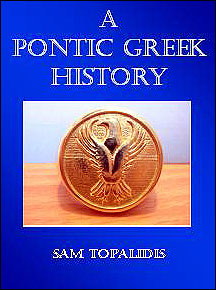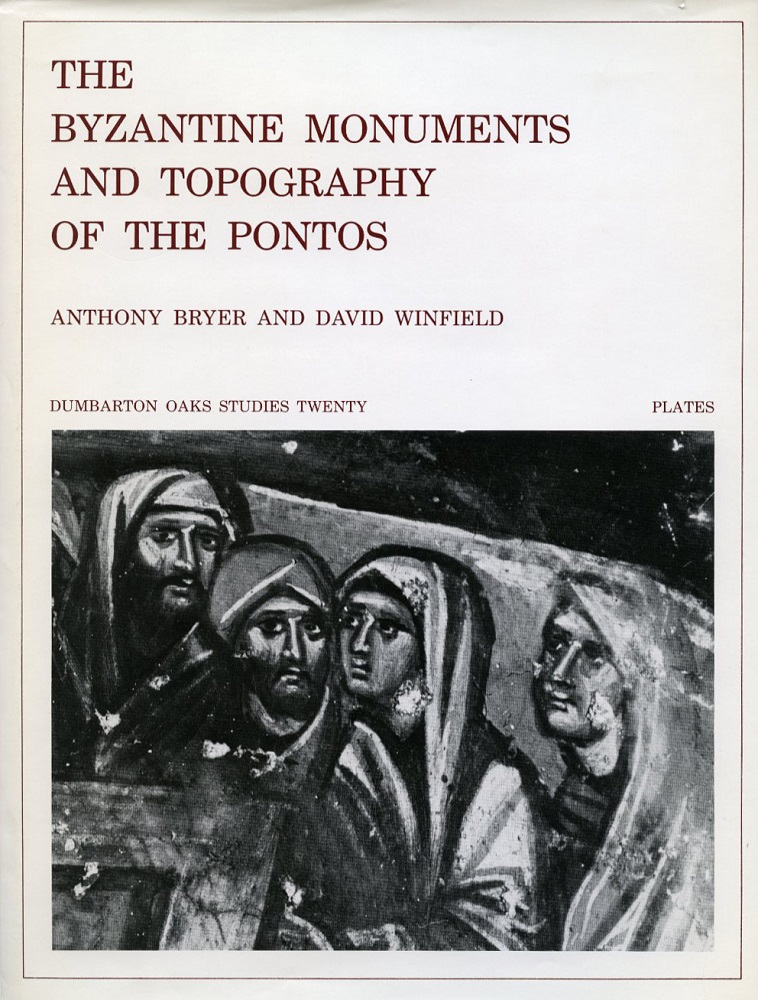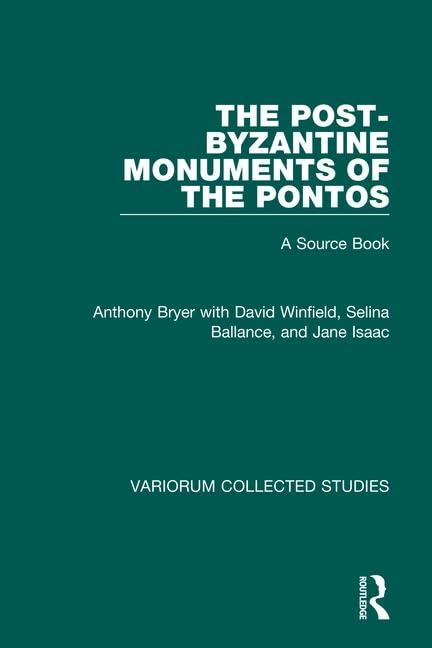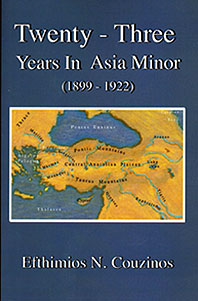
161 page, English.
Available by emailing the author directly at
Cost: AUS$23.50 for delivery within Australia (includes postage)
Please email the author for other destinations
A Pontic Greek History is not just a book filled with a thorough description of Pontic history. It's a book in which author Sam Topalidis explores his Pontic Greek roots in great detail. Tracing his parents' exodus from Pontos in 1918, to their arrival in Australia, Topalidis manages to weave his entire life story together by delving into his parents life in Pontos, exploring his family tree, and culminating with a voyage to the place where it all began, Pontos.
An excerpt from the book, pp 136-138A RETURN TO TRABZON IN SEARCH OF MY ROOTS
My brief family background involves my father and mother's families who were Pontic Greeks that departed Trabzon in 1918 with the exiting Russian Army during World War I. They settled in Sohoumi Georgia and after years of the harsh Stalin regime they left in 1939 for Larisa, Greece. There my parents married, survived the German occupation during World War II, started a family and then emigrated in 1953 to Australia.
My trip back to the Trabzon region of Asia Minor in October 2003 was a research trip of deep personal significance in order to trace more of my Pontic Greek roots. I was the first family relative to return to the Pontos in 85 years since my ancestors were forced to leave their homeland.
When I arrived in Trabzon I felt some very strong emotions - it was very difficult to explain. From the airport I jumped into a taxi and was whisked away to my hotel the ‘Horon' (what an appropriate name!). On route, I was captivated by the sights of the old town. It seemed that Trabzon had not changed since my ancestors lived there. The first thing I did after I checked-in at the hotel was to go to a travel agent and buy a ticket for the following day to visit the Sumela monastery.
Constantine Hionides (the well-known Pontic Greek from Boston) had previously sent me a magnificent photo of the monastery from one of his many visits there. Ever since then I had a strong passion to see the monastery for myself. After purchasing my ticket, I spent the remainder of the day negotiating the shops and at times, chaotic roads around the Meydan Square, which is the hub of activity in Trabzon.
I found a shop that sold traditional Turkish instruments and almost purchased a kemenche (Pontic lira) for my brother. (My brother's kemenches are of a considerably higher standard. His best kemenche is on display, on loan in the Hellenic Club of Canberra). I was about to purchase a kemenche, when the shop owner, after checking it was going to cost more to post to Australia than to purchase, told me, ‘don't buy it'. Therefore, I didn't.
I found the streets in the town narrow and polluted by car fumes. Sidewalks were also over-flowing with pedestrians. Shops were a mixture of the modern that would not be out-of-place in London or Sydney, but right next door could be a traditional Turkish shop that hadn't changed in at least 30 years. In relation to fashion, girls usually wore modern trendy clothes and businessmen wore business suits. Other than that, from my very biased western background, I thought the people could do with a fashion consultant. Trabzon is a town of 215,000 people and it is certainly a mixture of the old and the new.
The city does have modern conveniences like a McDonalds Restaurant (I can't believe I said that) and bars where alcohol is freely sold. To my great delight I found a shop that made fresh chocolate flavoured halva - which was the best I had ever eaten!
Off one of the main streets was the Trabzon Museum, which is housed, in a beautiful old mansion built by a wealthy Greek, where Ataturk once stayed. The mansion was a time capsule of the early 20th century with beautiful antique furniture. The museum in the basement had a small archaeological collection. It contained amongst other items 20 very old Greek icons that seemed to be several hundreds of years old. Labelling of items was almost non-existent and photographs unfortunately were not permitted.
After the trip to the museum I sat in the Ataturk Park at the Meydan Square eating great Turkish food. I looked at the many men sitting drinking their tea; coffee to my surprise was not as popular. I felt comfortable sitting there knowing that my ancestors came from this area. As I gazed at the men, it was obvious that I looked a bit like them. In fact, to my surprise, one old Turk walked up to me and spoke something in Turkish. I looked back at him initially in stunned silence and then said in English (I thought Greek would not be appropriate) ‘sorry sir I only speak English'. This startled the Turk, as he must have thought I was a local. He pointed to my watch, which I showed him - he just wanted to know the time. He walked away confused. This incident was repeated a few days later in the same park. It was obvious some Turks thought I was a local. (When I was in the Grand Bazaar in Istanbul, prior to visiting Trabzon, I came across two different vendors who told me, ‘you are from Trabzon as you have the Trabzon nose', i.e. men from this region have a majestic nose. After visiting Trabzon they were right!)
Anyway, on the second day, with my dolmus I visited the Sumela monastery, south of Trabzon. On route, there was some magnificent scenery. The location for the monastery has to be seen, it fills you with awe. I was astounded how high up the cliff-face the Greeks had built the monastery so long ago. In the couple of hours I explored the monastery I counted 80 visitors of which 70 were Turks.
Fog began to swirl around the monastery. Life here must have been extremely cold in winter. Before I left, I lit three candles, which I had brought from the Greek Orthodox Church in Canberra, in a secluded area of the monastery. My recently departed mother would have appreciated that.
At the parking spot to catch my dolmus back to Trabzon I spoke to a taxi driver who spoke broken English and asked him if he knew how to get to my mother's parent's village of Subashi (Zilmera). To my surprise he gave me a road map of the villages close to Trabzon identifying where it was located and we organised for him to drive me there tomorrow. I was quite excited and all the way back to Trabzon I speculated what I would find in my grandparent's village tomorrow.
Day three started with pouring rain. Undaunted I travelled by taxi to the 10 odd kilometres southwest from the Meydan Square to Subashi. It came as no surprise when we arrived at the village that I could see lots of hazelnut groves. After all, my grandparents had many hazelnut groves when they lived there.
Subashi looked like ‘a non-nucleated village'. I didn't find any old buildings, only relatively new farmhouses and a relatively new Mosque built on the small road that passed through the village. The area was very lush. There was no indication of old Greek houses or the small Greek Church that once existed there. The old Greek houses must have unfortunately been destroyed and replaced.
The taxi driver took me to the village's bus shelter/tea house where an old man greeted me with some tea and told me that Subashi used to be called Zilmera. So there is some memory of the old village name. This man, who looked Greek, took us up a steep hill nearby to identify the boundaries of the village. This was probably the very hill my grandmother saw the Russian ships enter Trabzon harbour in 1916 during World War I. The number of farmhouses didn't seem to have grown much from my grandparent's day.
I was very glad that I finally visited my mother's parent's village. I felt a degree of accomplishment. On the return trip down to Trabzon my taxi driver told me that his friend, Mehmet, was the grandson of Topal Osman. I felt a large lump in my throat. Topal Osman was the ‘butcher' responsible for killing countless Pontic Greeks in the early 20th century. I remained silent all the way back to Trabzon.
Once back at Trabzon I embarked on visiting the St Sophia church on the western boundary of the town. When I arrived it looked exactly like the photos I had previously seen of the church. It was indeed very old and it contained beautiful frescoes. The most brilliant frescoes were on the western entrance. Outside the church I saw many Greek tombstones leaning against a wall. The views from the church of the surrounding areas were brilliant. Further west along the Black Sea some 10 kilometres away was the town of Akchaabat (which the Greeks called Platana) where my father was born. Ah, a place to visit tomorrow.
On day four I woke very early, as usual, due to the call to prayer from the nearby local mosque. There is no need for an alarm clock here! In the morning I caught a dolmus and off I went to Akchaabat. In the dolmus I was stunned when a man jumped in who could have passed as a brother of one of Greek friends. Needless to say, I saw a few local people I would have sworn were Greek not Turkish. (For those who study Pontic history this is of no surprise.) Once I arrived in Akchaabat I walked the streets closest to the Black Sea. From this town the substantial haze over Trabzon could easily be seen. I also saw many hazelnut groves on the steep slopes behind Akchabaat. I walked the main shopping area and was grateful that it was not as busy or as polluted as Trabzon. This is no tourist town. It looked like a lot had not changed in 50 years. There were some old wooden houses but other than that nothing extraordinary to take note of. (In retrospect, I was not looking in the right places, something I will need to rectify in a future visit.)
After I walked back to Trabzon, I went to my regular friendly restaurant for ‘feeding and watering'. Near the Meydan a man walked past me and I swear I had seen a ghost. The man looked just like my departed father when he was in his 50s. The man even had missing front teeth and a couple of gold teeth similar to my father! It was a very uncomfortable experience.
On day five I caught a dolmus up the famous Boz Tepe (grey hill) southeast from the centre of Trabzon. The views were great. Looking over the harbour I remembered the story that my grandfather told my mother when the family was leaving this very port 85 years ago. My grandfather's nickname in Georgia was Katsakis (after the Turkish word Katchak for escapee, as he had escaped from the infamous Turkish labour battalions). As I looked northeast into the Black Sea in the direction of Sohoumi, Georgia where my ancestors went in 1918, it was hard not to feel a great deal of sadness.
When I left Trabzon the following morning I felt very satisfied that I made the effort to visit my ancestral homeland and turn a substantial page in my life. Although the Trabzon region is my ancestral home, I don't believe that I could live there. One thing that annoyed me was that most people smoked inside buildings and even when preparing food in restaurants.
When my plane from Trabzon arrived in Istanbul, I had a very unpleasant experience trying to convince the Turkish Immigration officials that I was an Australian citizen trying to fly to Athens. They were convinced I was a Turk from Trabzon with a forged Australian Passport trying to illegally leave the country. They kept on asking me ‘why is someone with a Turkish name from Trabzon trying to go to Athens'? I was not amused! Eventually they found an Australian traveller at the airport to talk to me to determine if I had an Australian accent. After I spoke three words to him, (as you could imagine my frustration), ‘what the f...', the Australian immediately said to the Turkish Immigration officials, ‘don't be stupid, of course he is Australian'. Only then was I allowed to leave the country. The Immigration officials apologised for my delay in boarding my plane. (On my next visit to the Pontos, I expect to have more difficulty entering Turkey rather than leaving.)
Finally, several weeks later, when I left Athens for Istanbul to catch my connecting flight for Australia, I observed just how serious the Turks took security at their airports. It was even more serious there than in Greece, Australia or Thailand. The next day after I departed, several terrorist bombs exploded in Istanbul with many lives unfortunately lost. I understood all too clearly why the Turks were so serious about airport security.


